Related Research Articles
The 1090s was a decade of the Julian Calendar which began on January 1, 1090, and ended on December 31, 1099.

Year 1098 (MXCVIII) was a common year starting on Friday of the Julian calendar.
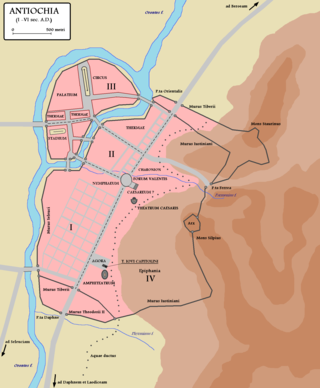
Antioch on the Orontes was a Hellenistic Greek city founded by Seleucus I Nicator in 300 BC. It was one of the greatest and most important Greek cities of the Hellenistic period. The city served as the capital of the Seleucid Empire and later as regional capital to both the Roman and Byzantine Empire. During the Crusades, Antioch served as the capital of the Principality of Antioch, one of four Crusader states that were founded in the Levant. Its inhabitants were known as Antiochenes. The modern city of Antakya, in Hatay Province of Turkey, was named after the ancient city, which lies in ruins on the Orontes River and did not overlap in habitation with the modern city.
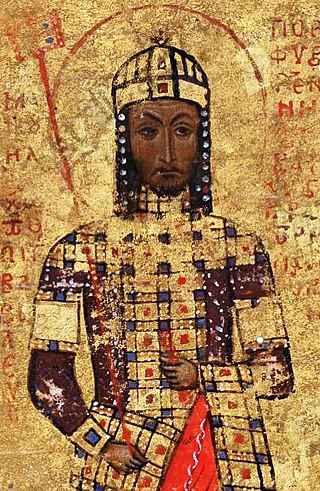
Manuel I Komnenos, Latinized Comnenus, also called Porphyrogennetos, was a Byzantine emperor of the 12th century who reigned over a crucial turning point in the history of Byzantium and the Mediterranean. His reign saw the last flowering of the Komnenian restoration, during which the Byzantine Empire had seen a resurgence of its military and economic power and had enjoyed a cultural revival.

The First Crusade (1096–1099) was the first of a series of religious wars, or Crusades, initiated, supported and at times directed by the Latin Church in the medieval period. The objective was the recovery of the Holy Land from Islamic rule. While Jerusalem had been under Muslim rule for hundreds of years, by the 11th century the Seljuk takeover of the region threatened local Christian populations, pilgrimages from the West, and the Byzantine Empire itself. The earliest initiative for the First Crusade began in 1095 when Byzantine emperor Alexios I Komnenos requested military support from the Council of Piacenza in the empire's conflict with the Seljuk-led Turks. This was followed later in the year by the Council of Clermont, during which Pope Urban II supported the Byzantine request for military assistance and also urged faithful Christians to undertake an armed pilgrimage to Jerusalem.
Bohemond I of Antioch, also known as Bohemond of Taranto or Bohemond of Hauteville, was the prince of Taranto from 1089 to 1111 and the prince of Antioch from 1098 to 1111. He was a leader of the First Crusade, leading a contingent of Normans on the quest eastward. Knowledgeable about the Byzantine Empire through earlier campaigns with his father, he was the most experienced military leader of the crusade.

The Principality of Antioch was one of the Crusader states created during the First Crusade which included parts of modern-day Turkey and Syria. The principality was much smaller than the County of Edessa or the Kingdom of Jerusalem. It extended around the northeastern edge of the Mediterranean, bordering the County of Tripoli to the south, Edessa to the east, and the Byzantine Empire or the Kingdom of Armenia to the northwest, depending on the date.
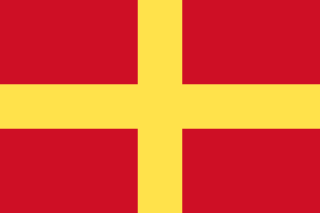
The County of Tripoli (1102–1289) was the last of the Crusader states. It was founded in the Levant in the modern-day region of Tripoli, northern Lebanon and parts of western Syria. When the Frankish Crusaders –
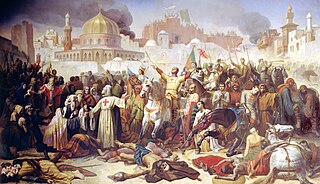
The siege of Jerusalem during the First Crusade lasted for one month and eight days, from 7 June 1099 to 15 July 1099. It was carried out by the Crusader army, which successfully captured Jerusalem from the Fatimid Caliphate and subsequently founded the Kingdom of Jerusalem. Having returned the city and the Church of the Holy Sepulchre to Christian rule, the siege was the final major armed engagement of the First Crusade, which had been proclaimed in 1095 to recover the Holy Land for the Christians in the context of the Muslim conquest. A number of eyewitness accounts of the battle were recorded, with the most quoted events being derived from the anonymous Latin-language chronicle Gesta Francorum.

The siege of Antioch took place during the First Crusade in 1097 and 1098, on the crusaders' way to Jerusalem through Syria. Two sieges took place in succession. The first siege, by the crusaders against the city held by the Seljuk Empire, lasted from 20 October 1097 to 3 June 1098. The second siege, of the crusader-held city by a Seljuk relieving army, lasted three weeks in June 1098, leading to the Battle of Antioch in which the crusaders defeated the relieving army led by Kerbogha. The crusaders then established the Principality of Antioch, ruled by Bohemond of Taranto.

Tancred was an Italo-Norman leader of the First Crusade who later became Prince of Galilee and regent of the Principality of Antioch. Tancred came from the house of Hauteville and was the great-grandson of Norman lord Tancred of Hauteville.

The siege of Damascus took place between 24 and 28 July 1148, during the Second Crusade. It ended in a crusader defeat and led to the disintegration of the crusade. The two main Christian forces that marched to the Holy Land in response to Pope Eugene III and Bernard of Clairvaux's call for the Second Crusade were led by Kings Louis VII of France and Conrad III of Germany. Both faced disastrous marches across Anatolia in the months that followed, with most of their armies being destroyed. The original focus of the crusade was Edessa (Urfa), but in Jerusalem, the preferred target of King Baldwin III and the Knights Templar was Damascus. At the Council of Acre, magnates from France, Germany, and the Kingdom of Jerusalem decided to divert the crusade to Damascus.

The siege of Lisbon, from 1 July to 25 October 1147, was the military action against the Muslim-ruled Taifa of Badajoz that brought the city of Lisbon under the definitive control of the new Christian power, the Kingdom of Portugal.

Maarat al-Numan, also known as al-Ma'arra, is a city in northwestern Syria, 33 km (21 mi) south of Idlib and 57 km (35 mi) north of Hama, with a population of about 58,008 before the Civil War. In 2017, it was estimated to have a population of 80,000, including several displaced by fighting in neighbouring towns. It is located on the highway between Aleppo and Hama and near the Dead Cities of Bara and Serjilla.

The Crusades were a series of religious wars initiated, supported, and sometimes directed by the Christian Latin Church in the medieval period. The best known of these military expeditions are those to the Holy Land in the period between 1095 and 1291 that were intended to reconquer Jerusalem and its surrounding area from Muslim rule. Beginning with the First Crusade, which resulted in the conquest of Jerusalem in 1099, dozens of military campaigns were organised, providing a focal point of European history for centuries. Crusading declined rapidly after the 15th century.

The siege of Ma'arra occurred in late 1098 in the city of Ma'arrat Nu'man, in what is modern-day Syria, during the First Crusade. It is infamous for the claims of widespread cannibalism committed by the crusaders.

The Normans were a population arising in the medieval Duchy of Normandy from the intermingling between Norse Viking settlers and indigenous West Franks and Gallo-Romans. The term is also used to denote emigrants from the duchy who conquered other territories such as England and Sicily. The Norse settlements in West Francia followed a series of raids on the French northern coast mainly from Denmark, although some also sailed from Norway and Sweden. These settlements were finally legitimized when Rollo, a Scandinavian Viking leader, agreed to swear fealty to King Charles III of West Francia following the siege of Chartres in 911. The intermingling in Normandy produced an ethnic and cultural "Norman" identity in the first half of the 10th century, an identity which continued to evolve over the centuries.

The First Crusade march down the Mediterranean coast, from recently taken Antioch to Jerusalem, started on 13 January 1099. During the march the Crusaders encountered little resistance, as local rulers preferred to make peace with them and furnish them with supplies rather than fight, with a notable exception of the aborted siege of Arqa. On 7 June, the Crusaders reached Jerusalem, which had been recaptured from the Seljuks by the Fatimids only the year before.
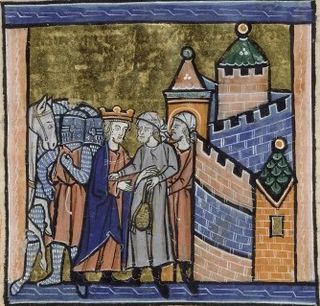
The siege of Shaizar took place from April 28 to May 21, 1138. The allied forces of the Byzantine Empire, Principality of Antioch and County of Edessa invaded Muslim Syria. Having been repulsed from their main objective, the city of Aleppo, the combined Christian armies took a number of fortified settlements by assault and finally besieged Shaizar, the capital of the Munqidhite Emirate. The siege captured the city, but failed to take the citadel; it resulted in the Emir of Shaizar paying an indemnity and becoming the vassal of the Byzantine emperor. The forces of Zengi, the greatest Muslim prince of the region, skirmished with the allied army but it was too strong for them to risk battle. The campaign underlined the limited nature of Byzantine suzerainty over the northern Crusader states and the lack of common purpose between the Latin princes and the Byzantine emperor.

Mongol Armenia or Ilkhanid Armenia refers to the period in which both Armenia and the Armenian Kingdom of Cilicia became tributary and vassal to the Mongol Empire in the 1230s. Armenia and Cilicia remained under Mongol influence until around 1335.
References
- 1 2 3 4 5 6 7 Payne, Robert (1984). The Dream and the Tomb: A History of the Crusades. Rowman & Littlefield. ISBN 978-0-8128-2945-7 – via Google Books.
- 1 2 3 4 Cohn, Norman (1970). The Pursuit of the Millennium: Revolutionary Millenarians and Mystical Anarchists of the Middle Ages. Oxford University Press. ISBN 978-0-19-987840-6 – via Google Books.
- ↑ Kostick, Conor (2008). The Social Structure of the First Crusade. Brill. ISBN 978-90-04-16665-3 – via Google Books.
- ↑ Rubenstein, Jay (2008). "Cannibals and Crusaders". French Historical Studies. 31 (4): 539–541. doi:10.1215/00161071-2008-005.
- ↑ Rubenstein 2008, p. 530.
- ↑ Rubenstein 2008, p. 551.